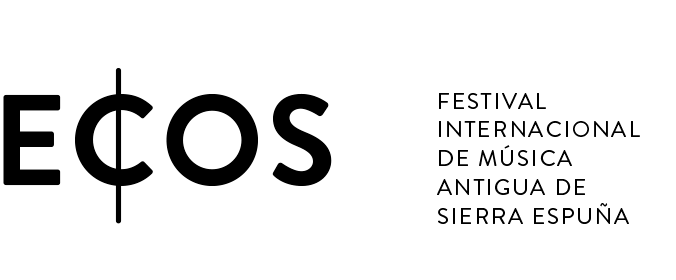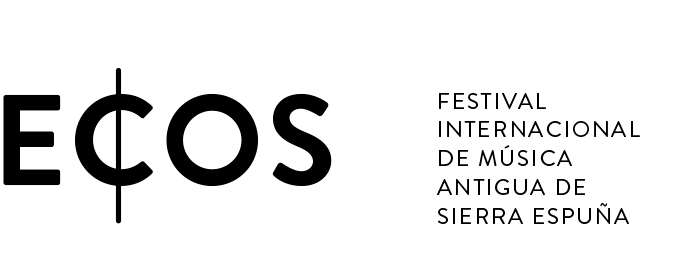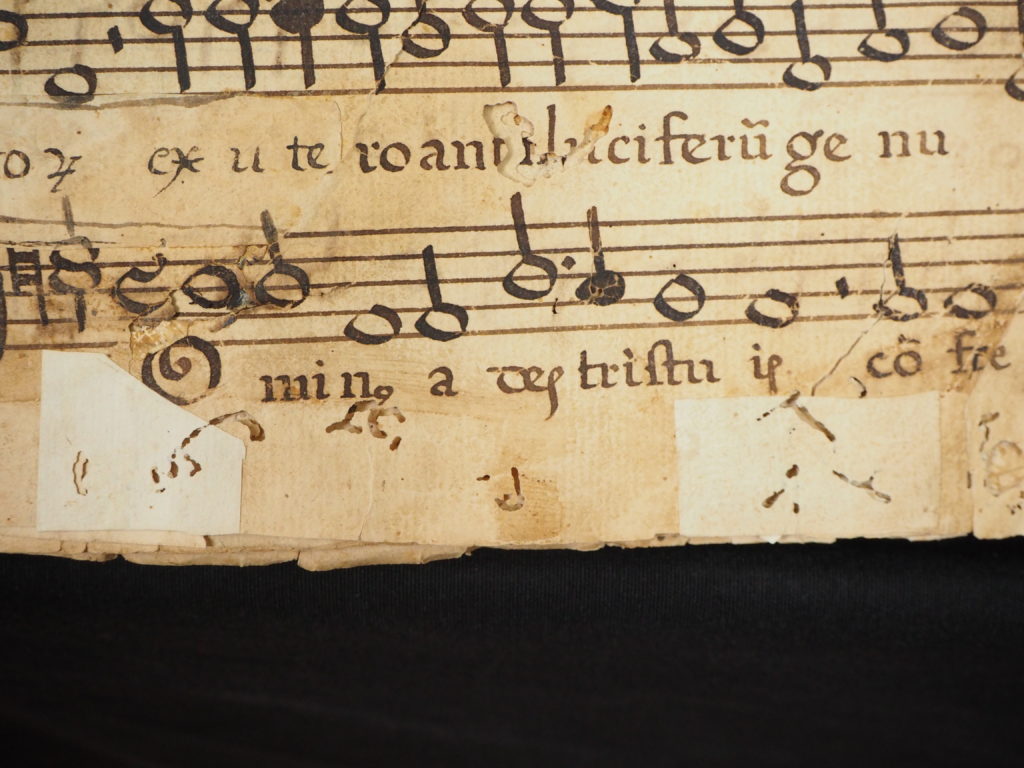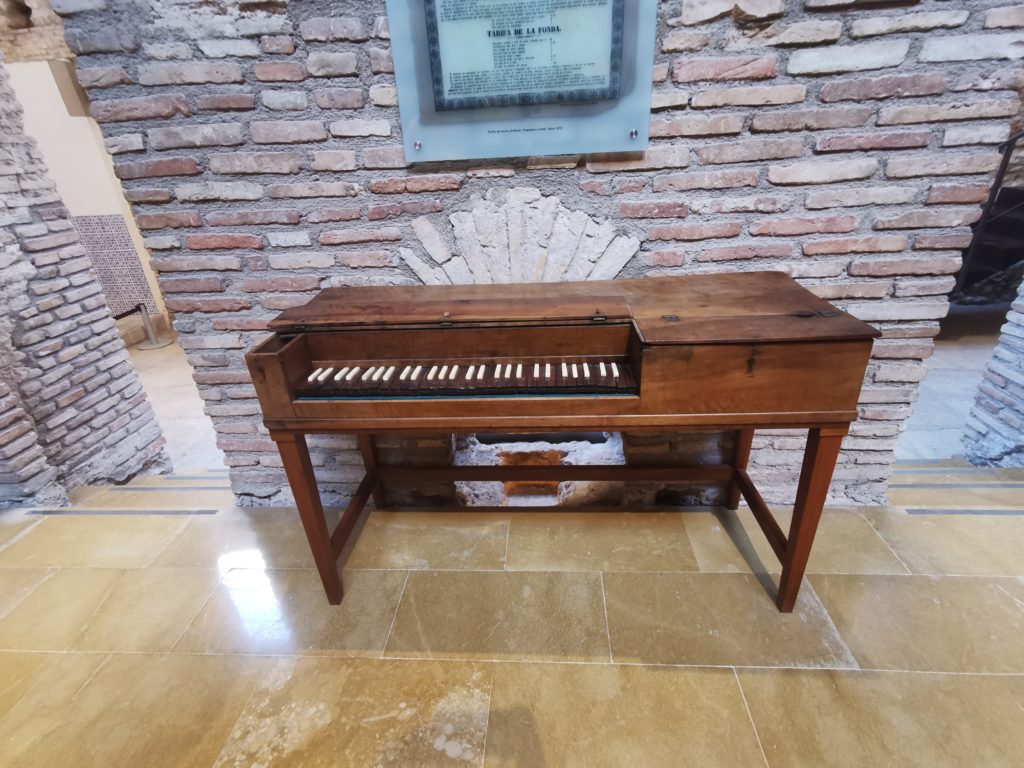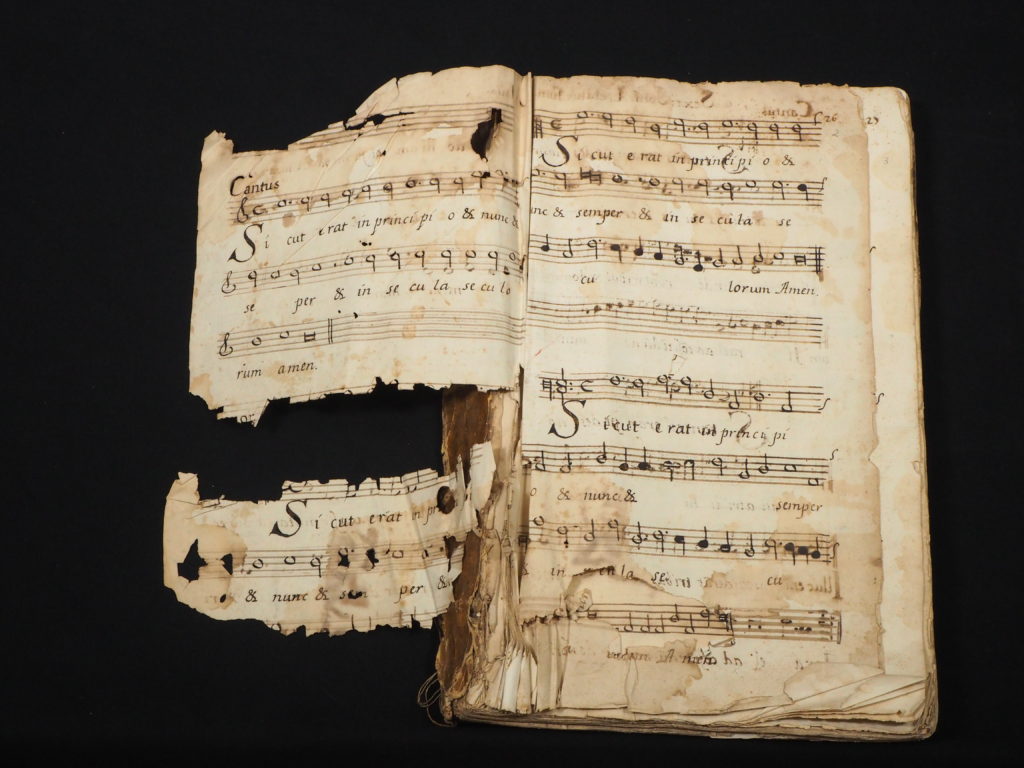KNOW THE TOTANA MANUSCRIPT
In July 2017, we discovered the Totana Manuscript in the museum of the Tower of Santiago el Mayor in Totana, a polyphony book copied in the late 17th and early 18th centuries. It contains about thirty sacred polyphony works by various Spanish authors, some of which were unknown until their discovery. The majority of the pieces are by Andalusian composers from the Renaissance, alongside two pieces by composers from the 18th century from the former Kingdom of Murcia: Tadeo Tornel and Francisco Gandía.
Among the works are motets, psalms for vespers, and two masses. In addition to their musical significance, they provide a faithful testimony of the era and its historical and cultural context.
From that moment on, we embarked on an exciting research project focused on the recovery, enhancement, and dissemination of the Totana Manuscript. Would you like to learn more about it?
TOTANA MANUSCRIPT
Do you know what a polyphony book is?
Polyphony or choir books were used by musical chapels to perform vocal music, often accompanied by the organ and wind instruments.
In choir books, each voice is separated from the others, allowing all performers to read from the same book, with the high voices (cantus and tenor) on the left page and the low parts (altus and bassus) on the right. Due to the size of this manuscript, it could have been used as a lectern book: large chant books and scores readable from a distance by the entire group of singers and instrumentalists (minstrels), used to perform plainchant and polyphony during liturgical celebrations.
Polyphonic music, along with Gregorian chant and organ music, was a means of embellishing the Catholic liturgy from the Council of Trent (16th century) until the Second Vatican Council (20th century). The most important churches, such as Santiago “el Mayor,” had choir masters, organists, wind instrumentalists (minstrels), and choir singers to perform it.
Works and contents of the Totana Manuscript
The first section contains motets and magnificats by the composer Juan Navarro “Hispalensis.” He was the maestro of Tomás Luis de Victoria at the Cathedral of Ávila and was a highly recognized author in his time. His music is preserved in numerous cathedral archives.
A second section includes motets and psalms by authors associated with Granada, such as the psalm “Beatus vir” and the motet “Hortus conclusus,” attributed to Rodrigo de Ceballos, maestro of the royal chapel of Granada between 1561 and 1581, and the psalms “Laetatus sum” and “Credidi,” assigned to Santos de Aliseda, maestro of the chapel of that cathedral between 1557 and 1580.
The manuscript also includes the antiphons “Vidi aquam” and “Asperges me” by the Aragonese composer Diego de Pontac, the Missa “O Rex gloriae” by the Sevillian composer Alonso Lobo, an anonymous psalm, another psalm, a motet, and the Missa “Saeculorum Amen” by the renowned Sevillian composer Francisco Guerrero, one of the main exponents of this genre (polyphony).
In the final section, we find three relatively complete works composed in the 18th century. These are the “Pueri Aebreorum” (For Palm Sunday) and “Gloria laus et honor” by Tadeo Tornel, and “Christus natus est nobis. Venite adoremus,” which bears the inscription “Invitatory for Christmas of Gandía, year 1805.” Given that these authors are from the Kingdom of Murcia, the presence of their works allows us to affirm that the Totana Manuscript originates from our land.
Composers from the Kingdom of Murcia in the Totana Manuscript
Tadeo Tornel. This significant instrument maker was born in Alhama de Murcia on February 20, 1729, and passed away around 1792. On February 28, 1778, he was admitted to the Royal Economic Society of Friends of the Country, coinciding with the entry of Salzillo, the “most eminent diocesan sculptor”: “The Society was informed that Mr. Dn. Francisco Zarzillo, celebrated and famous sculptor, Mr. Dn. Pedro Muñoz, who is a painter, and Mr. Dn. Thadeo Tornel, inventor of musical instruments” were all admitted.
He was a musician for the Choir of the Convent of Corpus Christi (Augustinian nuns) or the Chapel of Saint Cecilia. Two keyboard instruments crafted by him are preserved, one in the Museum of the Baths of Alhama de Murcia (photo) and another in the Museum of Fine Arts of Murcia. The archive of the Cathedral of Murcia also holds one of his musical compositions.
Francisco Gandía Herrero could be the author of the last work in the manuscript. From the limited available information, it is known that he was appointed Chapel Master of Hellín in 1773. Another work of his for Holy Week is preserved in the music archive of the Convent of Santa Clara in Hellín from the same year.
“Do you want to know more about the manuscript? Take a look at this article written by Jorge Losana and published in Melómano magazine”.
DISCOVERY, STUDY AND RESTORATION
In July 2017, Jorge Losana, director of the Early Music Project and the Workshop of Historical Music at the University of Murcia, during a visit to the museum of the Tower of Santiago el Mayor in Totana, came across a music manuscript that was part of the exhibition. He discovered the value of this piece, thus initiating its restoration process.
In 2018, Emilio Ros-Fábregas, a researcher in Musicology and director of the CSIC (Higher Council for Scientific Research) project “Spanish Polyphony and Oral Tradition Music in the Age of Digital Humanities,” affiliated with the Milá y Fontanals Institution for Humanities Research in Barcelona, conducted a detailed study of the work as a whole.
He later shared this study with the general public in a conference he delivered in 2021 at the Cathedral Museum of Murcia, which is now available for online viewing.
In July 2018, a conference-presentation on this subject was held at the Temple of Santiago el Mayor in Totana, complemented by a concert featuring pieces from the Totana Manuscript. Some of these pieces had premiered at the ECOS Festival in Sierra Espuña, at the Sanctuary of Santa Eulalia (La Santa).
After several centuries, this music echoed once again on a stage where it likely resonated in times gone by.
In June 2019, after several months of restoration work by technicians from the General Archive of the Region of Murcia, the Totana Manuscript was presented in all its splendor, reclaiming the magnificence of a piece that is part of the valuable heritage of the Region of Murcia. A few days later, it was unveiled in Totana in honor of the patron saint festivities dedicated to Santiago Apóstol.
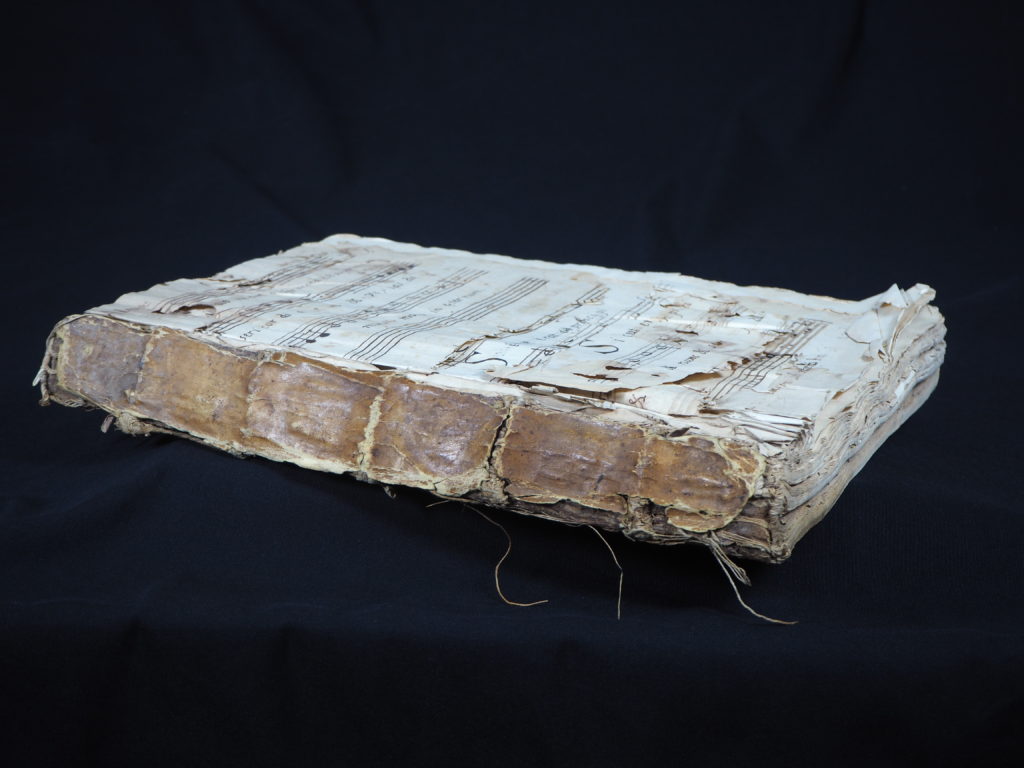
In the same year, sheet music for performance was prepared by Antonio Pardo, a professor and researcher in Musicology at the University of Murcia. The discovery was presented in July at the International Congress of Medieval and Renaissance Music, Med&Ren, held in Basel, Switzerland.
DISSEMINATION ACTIVITIES
Following its restoration and edition, we embarked on an intensive effort of dissemination and promotion to not only introduce its music, but also to highlight its historical significance and reflection of an era.
In October 2020, its unpublished music was premiered for the first time in modern times at the Basilica of San Miguel in Madrid, as part of the International Festival of Sacred Art of the Community of Madrid. Unfortunately, it couldn’t be pre-released in Totana due to Covid-19 health restrictions.
See Scherzo Press Release: Cantoría presents the ‘Totana Manuscript’ at the FIAS
On March 21, 2021, the music of the Totana Manuscript was recorded and internationally presented in digital format during the “Early Music Day” Festival of the European Network of Early Music (REMA). Additionally, it was broadcast on regional television channels such as 7 Región de Murcia and others at the local level.

In December 2021, the music was premiered in front of a live audience at the Santiago el Mayor Temple in Totana and at the San Lázaro Church in Alhama de Murcia. These concerts were complemented by a brief lecture by Jorge Losana and the physical presentation of the restored Manuscript to the public.

A few days later, on December 17, a concert commemorating the fifth centenary of the beginning of the construction of the Tower of the Cathedral of Murcia took place in the Los Vélez Chapel. The vocal group Cantoría, led by Jorge Losana, and the Gregorian Schola of Murcia were responsible for the performance.
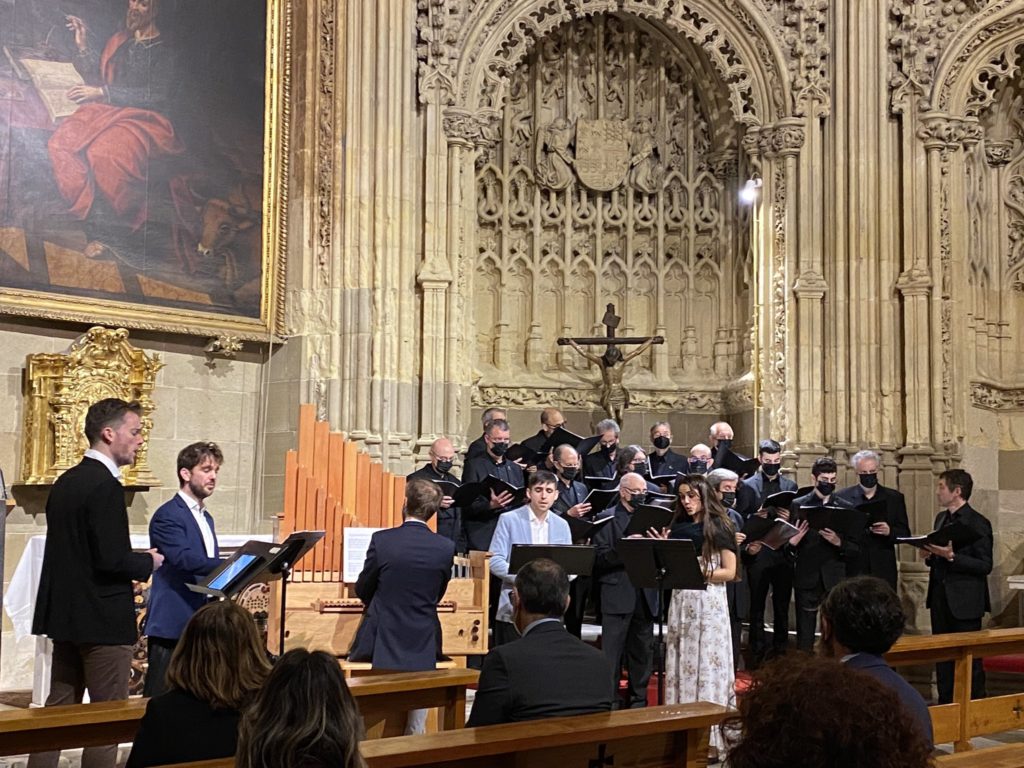
The event was complemented by a lecture given by Emilio Ros-Fábregas and the unveiling of three exhibition panels about the Manuscript, which later became part of the permanent exhibition at the Tower of Santiago Museum in Totana.

La Verdad. The Cathedral hosts the Murcia premiere of the 18th-century Totana Manuscript’s sacred polyphony concert.
THE DOCUMENTARY
The culmination of this project takes place with the production of the documentary “A Forgotten Book: The Totana Manuscript.” This documentary covers the entire process of discovery, the recovery process, and shows how this event has led to the internationalization of a region due to its tourist appeal, contributing to the cultural and historical identity of both Sierra Espuña and the rest of the Region of Murcia.
The documentary was first screened on July 14, 2022, at the Ginés Rosa Theater in Totana, and on Thursday, February 16, at the Francisco Rabal Regional Film Archive in Murcia. Subsequently, it has been shared through media outlets such as Oculto.tv and Allegro HD.
LISTEN TO THE PIECES FROM THE TOTANA MANUSCRIPT
Hortus Conclusus, Rodrigo de Ceballos (1525 – 1591)
We don’t know much about the early life of Rodrigo de Ceballos, but he was surely related to the cathedrals of Sevilla, Córdoba and Granada. In Granada, he was appointed as chapel master in the Capilla Real, something really important for a composer in the 16th century!
Beatus vir, Rodrigo de Ceballos (1525 – 1591)
The Psalm 111 has been used a lot by composers, like Monteverdi and Vivaldi, through the history of western music. In this Ceballos’ version it’s fascinating the way in which he uses the music to reinforce the meaning of the word “pauperibus” (poor). Pay attention to the sentence: “Dispersit, dedit pauperibus”. This piece is exclusively found in the Totana Manuscript.
Laetatus sunt, Santos de Aliseda (¿? – 1580)
Santos de Aliseda it’s also related to the Granada Cathedral. He was his chapel master in the central part of the16th century. Could you listen the joy of the tutti entrance in this Psalm 122? “Our feet are standing in your gates, Jerusalem! This piece is also exclusively found in the Totana Manuscript.
Asperges me, Magister Pontac (¿? – ¿?)
If you listen carefully, you will find the introductory sense of this antiphon. It was sung during the sprinkling of holy water at the beginning of the ceremonies. After the doxology, the main text it’s sung again.
Credidi, Santos de Aliseda (? – 1580)
For this Psalm 115, Santos de Aliseda composed an uplifting final doxology, related to the final statement of the “Credidi”: “Vota mea Domino reddam in conspectu omnis populi ejus” (I will fulfill my vows to the Lord in the presence of all his people). This piece is exclusively found in the Totana Manuscript.
Vidi aquam, Magister Pontac (¿? – ¿?)
The “Asperges me” was not sung in the Eastertide, but… What was sung instead? The “Vidi aquam”, that state: “I saw water flowing out of the Temple, from its right side, Alleluia: And all to whom this water came were saved, and they shall say: Alleluia, Alleluia.”
Dixit Dominus, Francisco Guerrero (1528 – 1599)
Francisco Guerrero’s music it’s also present in the Totana Manuscript. This “Dixit Dominus” it’s full of references to enemies, blood and rage. It can be heard on the first entry of the choir, and in the “The Lord upon thy right hand, shall wound even kings in the day of his wrath”.
Gloriose Confessore Domini, Francisco Guerrero (1528 – 1599)
With this fantastic motet from Guerrero, we would like to tell you something about the Church of Santiago el Mayor, Totana, where the manuscript was found. It was constructed between the 16th and the 18th centuries.
The discovery of the Totana Manuscript and its entire recovery process is a clear example of how the collaborative efforts of both public and private institutions can elevate the value of culture and heritage beyond the purely artistic, becoming a driving force in the internationalization of a region, the creativity of its residents, the attraction of tourism, the understanding of history, and the establishment of the identity of both Totana and the broader Sierra Espuña.
Thanks to the collaboration of the University of Murcia, Territorio Sierra Espuña, Totana City Council, the Cinema, Music, and Culture classrooms of the University of Murcia, ICA, ITREM, Festivales Región de Murcia, the Government of the Region of Murcia, the National Institute of Performing Arts and Music of the Ministry of Culture (INAEM), the European Union-Next Generation EU, as well as the various professionals involved in the project, it is now possible to continue showcasing this significant part of our material legacy.
Space funded by INAEM, Ministry of Culture and Sports, and European Union-Next Generation EU.

